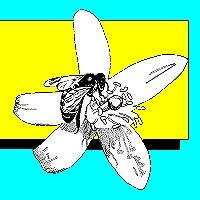APIS Volume 17, Number 4, April 1999

In this issue
- Yearly Honey Production: Historical Analysis
- Marketing Changes: What the Future May Hold
- Transgenic Plants and Bees: Further Implications
- Honey Loan Program Re-authorized:
- Brazilian Honey Shortage:
YEARLY HONEY PRODUCTION: HISTORICAL ANALYSIS
Honey production in 1998 from producers with five or more colonies totaled 220 million pounds, up 12 percent from 1997. There were 2.633 million colonies producing honey in 1998, a slight increase from 2.631 million in 1997. Yield per colony was up nine pounds in 1998 (83.7 pounds/colony) over 1997 (74.4 pounds/colony). Producer stocks were 80.8 million pounds on December 15, 1998, up 14 percent from 70.69.
In 1997, Florida had 240,000 colonies producing 16 million pounds, averaging 67 pounds/colony. That compared to 230,000 colonies producing 22.5 million pounds of honey, averaging 98 pounds/colony in 1998. In 1998, California ranked first in production at 450,000 pounds, followed by Florida and North Dakota tied at 230,000 pounds. In 1997, California produced 420,000 pounds and Florida ranked third in production at 240,000 pounds, just behind North Dakota’s 245,000 pounds.
Prices across the United States ranged from an average of $1.65 per pound in Nevada to $.58 per pound in Mississippi. The overall average price was $.65 per pound; Florida’s average was $.64 per pound. In 1997, Florida’s average price was $.73 per pound.
This information regarding honey prices comes from the U.S. Department of Agriculture’s monthly publication The National Honey Market News, USDA Agricultural Marketing Service, Fruit and Vegetable Division, 21 N. 1st Ave., Suite 224, Yakima, WA 98902-2663. The publication regularly reports on bee colony conditions in a number of states. Subscriptions cost $36 for addresses in North America. Call (509) 575-2494 to subscribe. Summary information, but not monthly reports on conditions, can be obtained from Florida Agricultural Statistics Service (ASS), P.O. Box 530105, Orlando, FL 32853-9840, tel. 407/648-6013 <http://www.nass.usda.gov/fl/rtoc0.htm>.
The Florida ASS World Wide Web site allows comparison over the last decade. The Service also faxed me a summary from 1986 through 1998. Over that 12-year period, the number of colonies in the United States dropped from 3.4 million in 1989 to 2.58 million in 1996, leveling off at 2.6 million for the last two years. Yield was lowest in 1989 (51.4 pounds/colony), gradually increasing to the 1998 high of 83.7 pounds/colony. Total production has climbed from a low of 177 million pounds in 1989 to a high of 230 million pounds in 1993, decreasing to 196 million pounds in 1997, and rising to 220 million pounds last year. These figures appear to indicate that beekeepers are becoming more efficient, producing more honey with fewer colonies. The Florida situation parallels the national scene to a degree. In 1986 there were 290,000 colonies in the Sunshine State, producing 21.7 million pounds of honey. In 1998, 230,000 colonies produced 22.5 million pounds of honey. Colony count has remained steady at 230,000 colonies over the last four years, up very slightly from previous years (1990-1993 averaging 220,000 colonies).
U.S. honey prices have shown very little upward movement in general except for 1996, when they topped $.88/pound for the first time <http://www.ifas.ufl.edu/~mts/apishtm/apis96/apmay96.htm#1>. The price dropped to $.75/pound in 1997 and stood at $.65/pound last year. During 1986-1994, prices ranged from $.49 to $.55/pound. There is great inconsistency in prices among states. For example, in 1998 average price per pound varied from $1.65 in Nevada to $.58 in Mississippi. At least 10 states report an average price above $1 per pound, while the vast majority are in the $.50 to $.80 per pound range. Glancing at the figures appears to indicate that states with fewer colonies and less production have the highest prices (IL, KY, MD, NV, VT, VA). This appears to indicate that beekeepers in these states are receiving a higher return, probably because many are retailing their honey. The large producing states are languishing in the $.64/pound range, since much of that honey is sold wholesale.
MARKETING CHANGES: WHAT THE FUTURE MAY HOLD
Given the historical trends revealed above, it is no surprise that honey producers continue to be caught between rising operating costs and continually low returns, even while they appear to be becoming more efficient. Many strictly blame retailers (packers, supermarkets) for the pricing situation. They are not alone in this regard. An article in the Florida Farm Bureau’s FloridAgriculture (April 1999, p. 4), titled "Retail Changes Affect Agriculture," reveals that prices at the retail level may have little connection with those at the farm gate. The article quotes a letter written by Polk County citrus grower Richard Lingenfelter: "All indications lead to the fact that last year was the most economically devastating season for U.S. citrus growers and farmers in years. At the same time it was the most lucrative for the retail industry because of its ability to manipulate the price paid for produce and control the inflated profits that are ultimately charged to the consumer."
The article also reports on a study by Dr. Pat Byrne of the Food and Resource Economics Department, University of Florida. Retailers practice what is called value-based pricing, according to Dr. Byrne. This means they charge what consumers are willing to pay. Thus, retail prices are only partially driven by wholesale costs, and only one-fifth of increases in those prices may be passed on at the retail level. According to Dr. Byrne’s study, this happens for many Florida vegetable commodities, with the sole exception of sweet corn. The bottom line is that rises or declines in the price received by the farmer usually do not immediately result in corresponding shifts at the retail level.
The article says that understanding how agricultural products are priced at the retail level is not to condemn retailers. Rather it reveals that they, like many producers, are operating in a climate of increased competition and consolidation. Retailers, on the other hand, are not totally unsympathetic with producer concerns and are seeking to use programs such as Fresh From Florida <http://www.ifas.ufl.edu/~mts/apishtm/apis97/apoct97.htm#5> and Farm Bureau’s Good Check Out Day to more actively move Florida produce. Dr. Byrne’s study has led to a potentially valuable long-term dialogue between producers and retailers, the article states. In the meantime, it concludes that producers must acquire more power within the marketplace. Some options for produce growers include expanding production acreage, extending the production season, and taking on more packing and shipping responsibility.
The Florida Fruit and Vegetable Association (FFVA) has asked the USDA to determine how recent consolidation of the nation’s supermarket industry is impacting growers of fruits and vegetables, according to Citrus and Vegetable Magazine (April 1999, pp. 14-16). FFVA president Mike Stuart has written a letter to U.S. Agriculture Secretary Dan Glickman, stating that as buying power concentrates in the retail sector of the food industry, produce growers face increased downward pressure on prices in the marketplace. This is as much a consumer issue as a grower issue, Mr. Stuart said. Supermarket consolidation has concentrated retail bargaining power, giving supermarkets greater leverage over growers. If grocery retailers are able to negotiate lower prices and other concessions from growers, are they passing these savings on to consumers? Secretary Glickman has warned of the dangers of consolidation, according to the article. It quotes him as saying: "The American free enterprise system depends on adequate competition to ensure there are choices available in the marketplace."
Produce prices, like those for honey, are also governed by the global marketplace. And it is change in that arena that is also driving the long-term situation, according to Dr. Steven Blank, cooperative extension economist at the University of California, Davis. He is author of The End of Agriculture in the American Portfolio. According to the World Wide Web site advertising this work <http://info.greenwood.com/books/1567201/1567201652.html>:
"American agricultural production is destined to end, argues Steven Blank, but this should be no cause for alarm. In this work, he shows that the changes leading to the end of American agricultural production are part of a natural process that is making us all better off. Beginning with broad observations from history and the current status of agriculture around the world, Blank explores how the decisions of individuals combine to make the end of American agricultural production predictable and rational. The inevitable creeping of international economic development is shown to be the sum of individual struggles facing producers across America and around the world. Also, decisions regarding operating an agricultural business derive from many interrelated peculiarities of the industry, both in America and elsewhere. The story is fascinating in its global scope and is relevant to everyone because the simple economic decision-making processes involved will be repeated in the story of other industries."
The April 1999 Futurist magazine (pp. 22-27) also discusses Dr. Blank’s work in some detail <http://www.wfs.org/ap99.htm>. He describes European agriculture as a trend setter. "Small, rich European countries were the first to be forced to face the end of agriculture. Switzerland, Belgium and the Netherlands are examples of countries that have nearly abandoned farming. They had no choice. They did not have much land, so their populations’ food demands had outgrown their ability to produce long ago. As the production of various food products was given up and reliance on imported products increased, the countries were able to pay for the imports with their incomes from the sale of other, more valuable products that were produced domestically. A lot of Swiss farmers, for example, found that making cuckoo clocks (and other manufactured goods) during the cold winters rewarded them with higher incomes. He quotes the German agriculture minister as promoting tourism in rural areas over farming. The bottom line, according to Dr. Blank, is that agriculture is an increasingly expensive lifestyle that is no longer easily supportable in the United States.
Commercial honey producers cannot but be affected by many of the changes described above. Certainly global issues described by Dr. Blank directly affect Florida produce growers, given that honey is a world commodity. Whether the end of farming as he sees it will also signal the same for beekeeping, however, is controversial. Although one can import food, as Dr. Blank says, it is difficult to import pollination. On the other hand, as large-scale agricultural production suffers either through supermarket consolidation or other reasons, so could commercial pollination.
Beekeepers have always been in a somewhat different class than those growing and marketing produce, but they have similar problems. To see that survival is possible and what forms it might take, however, one only need look to Europe, where the end of large-scale farming as described by Dr. Blank may have first come to fruition, and where much of modern apicultural practice began. Beekeeping remains a healthy, economically viable activity in France, for example, in spite of the many challenges posed by the global marketplace. For a description on how and why this may be occurring see the March 1997 APIS <http://www.ifas.ufl.edu/~mts/apishtm/apis97/apmar97.htm#1> and the index of reports sent to the APIS-L list while I was in France on sabbatical <http://www.ifas.ufl.edu/~mts/apishtm/letters/aixind.htm>.
TRANSGENIC PLANTS AND BEES: FURTHER IMPLICATIONS
Dr. Guy Poppy, research entomologist at Institute of Arable Crops Research (IACR) Rothamsted, UK <http://www.res.bbsrc.ac.uk/entnem/>, has written an editorial concerning transgenic plants and honey bees in Bee World(Vol. 78, Nol 4, 1998). I reported on this phenomenon in both the January 1998 <http://www.ifas.ufl.edu/~mts/apishtm/apis98/apjan98.htm#3> and February 1998 APIS <http://www.ifas.ufl.edu/~mts/apishtm/apis98/apfeb98.htm#7>. Indeed, it is so prevalent that the suggestion has been made I make a separate topical index for this issue alone on the APIS web site <http://www.ifas.ufl.edu/~mts/apishtm/threads.htm>.
The purpose of his editorial is to provide a "more complete" account of the implications of this technology, according to Dr. Poppy. He recognizes several kinds of genetically modified crops, both insect-resistant and herbicide-resistant varieties. Significantly, in studies of the former where protein inhibitors are used, there is no effect on bees until the dose tested is 100 times that found in genetically modified crops, and these were not detectable in nectar and pollen <http://www.ifas.ufl.edu/~mts/apishtm/apis97/apapr97.htm#4>. Dr. Poppy also mentions that use of insect-resistant crops can lead to reduced pesticide use and less subsequent damage to honey bees and other nontarget organisms. Any risk from transgenic crops, therefore, must also be weighed against those posed by conventional insecticide use.
Several risks involved in transgenic technology could affect humans/bees, Dr. Poppy says. One is the use of antibiotic-resistant genes that could lead to development of antibiotic resistance pathogens elsewhere. Thus, advisory committees are now recommending that alternatives be developed to obviate this risk. Another problem involves flow of pollen (genes) vectored by bees from transgenic plant species through hybridization to those that humans don’t want to be resistant, so-called "weedy" species. Finally, attractiveness of nectar to honey bees and usefulness of pollen from transgenic crops is also a concern. As a direct benefit, Dr. Poppy says transgenic technology could well allow for development of plants particularly attractive to honey bees.
In a related article in The Futurist, April 1999, Robert Shapiro, CEO of Monsanto Corporation, discusses the use of transgenic organisms in "How Genetic Engineering Will Save Our Planet." With an increasing population that wants to eat better, Mr. Shapiro says that new technology is the only alternative to two possible disasters: not feeding people or causing ecological catastrophe. This is because humans cannot continue to increase yields with what he calls "stuff:" pesticides, fertilizers, etc. He says it is impossible to greatly increase stuff on this finite planet, but it is possible to do so with the stuff’s information component. This includes the genetic material DNA, which is information at a basic but important level. He predicts that in the early 21st century there will be a struggle between information technology (biotechnology) on the one hand and environmental degradation on the other. This appears to be a variation of saying that working smarter, not harder will be more efficient. As Mr. Shapiro concludes, the substitution of information for stuff is essential to sustainability <http://csab.wustl.edu/home.asp>.
The Union of Concerned Scientists has developed a World Wide Web site that discusses the risks and benefits of biotechnology. It describes the process as going beyond traditional plant and animal breeding, and a radically new technology for altering the traits of living organisms by adding genetic material that has been manipulated outside of cells. Since gene transfer occurs by artificial means without regard to natural boundaries, genetic engineering permits combinations of genes and traits not found in nature, the site says. The technology, therefore, allows scientists to rearrange and modify genetic material before transfer and may one day encompass the routine addition of novel genes that have been wholly synthesized in the laboratory <http://www.ucsusa.org/agriculture/index.html>.
In conclusion, Dr. Poppy says honey bees are so far being carefully considered in the debate on the environmental impact of genetically modified plants or organisms (GMOs). As yet, there have been no serious effects discovered affecting honey bees when working with real plants or diets containing naturally occurring levels of the foreign protein found in transgenic plants. However, it is important to understand that the insects encounter the whole transgenic plant, Dr. Poppy says, not just a single or subset of proteins, and this must be taken into consideration. Thus, it is vital to consider all facts about GMOs when determining the possible benefits and/or potential detrimental effects. Therefore, Dr. Poppy says, it is imperative that more research is undertaken on honey bee-transgenic plant interactions. We must try to ensure that ecological studies do not become the poor cousin of biotechnological ones.
HONEY LOAN PROGRAM RE-AUTHORIZED:
The February 1999 Speedy Bee (Vol. 28, No. 2) carries notice that the USDA Farm Service Agency (FSA) began writing honey loans on March 8, 1999. A higher loan fee is necessary for honey loans in order for them to operate on a "no net cost basis." The loan fee is 9/10 of a cent per pound of honey put under loan. Loans are available only until May 7. For more information contact your nearest FSA office <http://wwwaix.fsa.usda.gov/areamap.htm>. The Florida State executive director is Kevin L. Kelley, tel. 352-379-4500.
BRAZILIAN HONEY SHORTAGE:
The March issue (No. 50) of Mensagem Doce (Sweet Message), published by Associação Paulista de Apicultores (APACAME), <http://www.apacame.org.br/> begins with an editorial titled "A Sense of Responsibility." Brazil began 1999 with an atypical situation: no honey! This is the result of certain climatic conditions in 1997 and 1998. Given this situation, the editorial reads, it is impossible not to pack honey. Too many companies depend on the sweet. The only alternative is to import honey from Argentina and Uruguay. This will be a defining moment for both Brazilian enterprise and government to prevent introduction of the bacterium Paenibacillus larvae, the causative organism of American foulbrood, into the country. The editorial concludes that much of Brazilian agriculture also depends on a healthy honey bee population. Although it is not reported how much honey Brazil might import, this may take some of the pressure off both Argentina and Uruguay to sell their sweet to either the United States or Europe.
That Brazil has yet to be infested with American foulbrood is remarkable; few other countries have been so lucky. Although not mentioned in the editorial, of more concern perhaps is the fact that antibiotic-resistant Paenibacillus larvae was first identified in Argentina <http://www.ifas.ufl.edu/~mts/apishtm/papers/FIFTH.HTM#5>. If this is introduced to Brazil, it could be a tougher fight to control the disease where this tool has been removed from the beekeeper’s array of options.
Sincerely,
Malcolm T. Sanford
Bldg 970, Box 110620
University of Florida
Gainesville, FL 32611-0620
Phone (352) 392-1801, Ext. 143 FAX: 352-392-0190
http://www.ifas.ufl.edu/~mts/apishtm/apis.htm
INTERNET Address: MTS@GNV.IFAS.UFL.EDU
©1999 M.T. Sanford "All Rights Reserved"






















